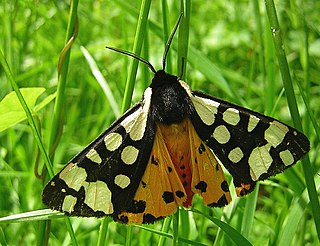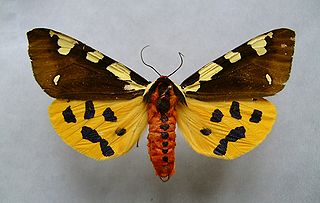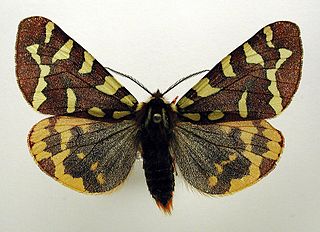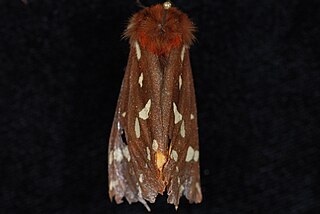
The Arctiina are a subtribe of moths in the family Erebidae.

Arctia is a genus of tiger moths in the family Erebidae. Therein, it belongs to the subtribe Arctiina in the tribe Arctiini in the subfamily Arctiinae. Species are well distributed throughout North America, Palearctic, India, and Sri Lanka.

Arctia is species of tiger moth in the family Erebidae. It was first described by Carl Linnaeus in his 1758 10th edition of Systema Naturae. It can be found in central and eastern Europe, Kazakhstan, southern Siberia, northern Mongolia, Amur Region, Primorye, Sakhalin, Kunashir, northern and northeastern China, Korea and Japan.

Arctia virginalis, the Ranchman's tiger moth, is a species of tiger moth in the family Erebidae. It was first described by Jean Baptiste Boisduval in 1852.

Arctia alpina is a moth of the family Erebidae. It is found in northern Scandinavia, northern Siberia, high mountains of southern Siberia and northern Mongolia; also in Alaska and northwestern Canada.

Arctia lapponica is a moth of the family Erebidae first described by Carl Peter Thunberg in 1791. It is found in northern Eurasia and the Arctic part of North America.
Arctia churkini is a moth of the family Erebidae. It was described by Saldaitis, Ivinskis and Witt in 2003 and is endemic to Kyrgyzstan.
Arctia cornuta is a moth of the family Erebidae. It was described by Saldaitis, Ivinskis and Witt in 2004. It is found in the Turkestan Mountains at the Uzbekistan-Tajikistan border.
Arctia khumbeli is a moth of the family Erebidae. It was described by Otto Bang-Haas in 1927. It is found in the Tian Shan of China.
Arctia kolpakofskii is a moth of the family Erebidae. It was described by Sergei Alphéraky in 1882. It is found in eastern Tien Shan in Xinjiang, China.
Arctia seitzi is a moth of the family Erebidae. It was described by Andreas Bang-Haas in 1910. It is found in central Asia, including Kazakhstan and Kirghizia.
Arctia bundeli is a moth of the family Erebidae. It was described by Vladimir Viktorovitch Dubatolov and Vladimir O. Gurko in 2004. It is found in Tadjikistan.
Arctia gurkoi is a moth of the family Erebidae. It was described by Vladimir Viktorovitch Dubatolov in 2004. It is found in Pakistan and possibly Xinjiang, China.
Arctia subnebulosa is a moth of the family Erebidae. It was described by Harrison Gray Dyar Jr. in 1899. It is found in Alaska, Yukon and the Russian Far East.
Arctia yarrowii, or Yarrow's tiger moth, is a moth of the family Erebidae. It was described by Richard Harper Stretch in 1874. It is found in North America from Hudson Bay to British Columbia and northern Arizona. The habitat consists of barren rocky fellfields and slides above the timberline. These moths are also found in the Pacific Northwest.
Arctia ornata is a moth in the family Erebidae. It was described by Otto Staudinger in 1896. It is found in the Russian Far East and Mongolia.

Arctia parthenos, the St. Lawrence tiger moth, is a moth in the family Erebidae. It was described by Thaddeus William Harris in 1850. It is found in boreal North America, ranging from Alaska to Labrador, south to New Mexico and Arizona in the Rocky Mountains and to North Carolina in the Appalachian Mountains. The habitat consists of riparian areas and mixed hardwood-conifer forests at middle to high elevations.
Arctia souliei is a moth in the family Erebidae. It was described by Charles Oberthür in 1903. It is found in Tibet and Sichuan in China.
Arctia allardi is a moth in the family Erebidae. It was described by Charles Oberthür in 1911. It is found in China.
Arctia kasnakovi is a moth in the family Erebidae. It was described by Vladimir Viktorovitch Dubatolov in 1987. It is found in Qinghai, China.






